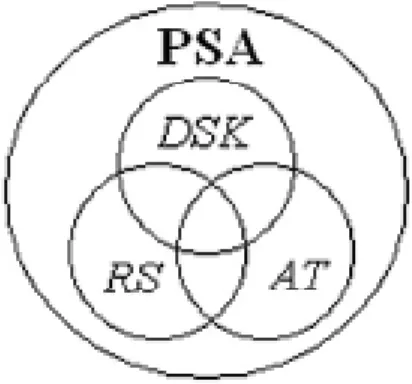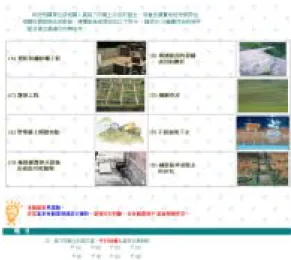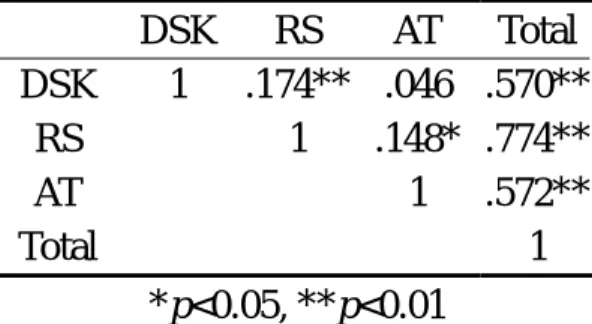行政院國家科學委員會專題研究計畫 期中進度報告
總計畫(2/3)
計畫類別: 整合型計畫 計畫編號: NSC93-2524-S-009-003- 執行期間: 93 年 08 月 01 日至 94 年 07 月 31 日 執行單位: 國立交通大學教育研究所 計畫主持人: 蔡今中 共同主持人: 張俊彥,周倩 報告類型: 精簡報告 處理方式: 本計畫可公開查詢中 華 民 國 94 年 5 月 26 日
行政院國家科學委員會專題研究計畫期中報告
認知、心理、語言與科學數位學習之整合型研究總計畫
An Interdisciplinary on Cognition, Psychology, Language and Science E-Learning (2/3)
計畫編號:NSC 93-2524-S-009-003
執行期限:93 年 8 月 1 日至 94 年 7 月 31 日
主持人:蔡今中
執行機構及單位名稱:國立交通大學教育研究所
本整合計畫綜合認知、心理、語言三大面向之數位學習研究。首先, 本計畫開發一系列有關網路學習環境之量表。並已刊登在今年 Educational Technology & Society 及 Educational Studies 的期刊中,此外本計畫針對國 立台灣師範大學物理系副教授黃福坤老師所建置之物理科學習討論區,進 行分析與調查,相關成果將於近日將於近日整理調查。其次,本研究主要工作在於協助其他子計畫研究之進行。本計畫每月 定期舉行一次討論會議,經由相互討論、激盪與交流,使各子計畫能夠順 利進行。茲將各子計畫之工作項目與現況簡述如下:
壹、子計畫一:數位學習環境中學生之科學問題解決能力的探討(2/3)
Abstract: This study examined tenth-grade students' (n =263) problem solving ability (PSA) online by tapping students' domain-specific knowledge (DSK), reasoning skills (RS), and attitudes toward (AT) the subject with respect to debris-flow-hazard related topics in a secondary school of Taiwan. The students' PSA was evaluated based on a previous model (Chang, 2004) which empirically established that students' PSA is a composite of DSK, RS and AT subscales. Major findings are as follows: (a) The correlation coefficients among students' DSK, RS and AT were relatively small, indicating that these subscales might have successfully represented different constructs of students' PSA; (b) A significantly positive correlation existed between students' PSA total scores and each subscale. It is, therefore, suggested that students' PSA may be potentially assessed online by measuring their essential components in the area of Earth sciences.
Introduction
Developing and enhancing problem-solving ability have long been important objectives of science education. Recent science education standards in the USA propose, ‘Teaching must involve students in inquiry-oriented investigations in which they interact with their teachers and peers. . . . they apply science content to new questions; they engage in problem solving, planning, decision making, and group discussions’ (NRC 1996: 20).
Problem-solving ability is generally viewed as the ability to think critically, to reason analytically, and to create productively, which all involve quantitative, communication, manual, and critical-response skills (AAAS 1993). In several previous studies, we found that students’ problem-solving ability (PSA) and their domain-specific knowledge (DSK), reasoning skills (RS), and attitudes (AT) are closely tied together (Chang & Weng, 2002; Chang, 2004). We have also empirically established that students’ PSA is basically a composite of DSK,
RS and AT subscales (Chang, 2004) as shown in Figure 1.
Therefore, this study took further steps and attempted to assessing students’ problem solving ability online through mapping their domain-specific knowledge of, reasoning skills in, and attitudes toward debris-flow-hazard related topics in the area of Earth sciences in a secondary school of Taiwan.
Figure 1: The PSA as a composite of DSK, RS and AT in the area of Earth
sciences
Method
The participants in the study were 263 tenth grade students (131 females and 132 males), with a mean age of 16, enrolled in a compulsory Earth science course (seven Earth science classes) at a public senior high school located in the central region of Taiwan. The Earth science course, taught two hours per week for one semester, is required of every tenth-grade student in the secondary schools in Taiwan.
Data were obtained online on students’ domain-specific knowledge and reasoning skills as well as attitudes through the use of the Domain-Specific Knowledge Test (DSKT), the Reasoning Skills Test (RST), and the Attitudes Test (AT) in the area of Earth sciences to inquire their common interrelationship. The web-based DSKT and RST are illustrated in Figure 2 and 3, respectively.
Figure 2: One item example of DSKT
Figure 3: One item example of RST
Design and Data Analysis
A correlation research design (Campbell & Stanley, 1966) was adopted by the study. The participants were tested online with the web-based DSKT, RST and AT for a total of two hours in December, 2004. The relationships among students’ domain-specific knowledge, reasoning skills and attitudes were then determined for the total group of students using a Pearson product-moment correlation method. According to Cohen’s rough characterization (1988, pp. 78-83), r = 0.1 is deemed as a small effect size, r = 0.3 a medium effect size, and r = 0.5 as the large effect size, in light of the nature and characteristics of behavioral or social sciences. Tests of the assumptions for the correlation and analyses were undertaken using SPSS 11.5 (Statistical Package for Social Sciences version 11.5).
Results and Discussions
Table 1 presents a 4 X 4 matrix of Pearson product-moment correlation coefficients on students' DSKT, RST, AT and their composite (PSA total) scores. The findings revealed that (1) the correlation coefficients among students’ DSK, RS and AT were quite small ranging from only 0.046 to 0.174 (r2 = 0.02 ~ 0.03, small effect sizes), indicating that these subscales might have successfully represented different constructs of students’ PSA, as shown in the RS and AT columns of Table 1, respectively; (2) a significantly positive and high correlation existed between students’ total scores and their DSK (r = 0.570,p
< 0.01), RS (r = 0.774,p < 0.01) and AT (r = 0.572,p < 0.01) scores, with generally large effect sizes (r2 = 0.32 for DSK , r2 = 0.60 for RS and r2 = 0.33 for AT) as illustrated in the last column of Table 1.
DSK RS AT Total DSK 1 .174** .046 .570** RS 1 .148* .774** AT 1 .572** Total 1 *p<0.05, **p<0.01
Table 1: Summary of Pearson product-moment correlation coefficients among
students’ DSK, RS, AT and their composite (PSA total) scores Overall, there existed significantly positive correlations between students’ problem-solving ability and their domain-specific knowledge, reasoning skills and attitudes of tenth-grade students in the area of Earth sciences in a secondary school of Taiwan, correlations are great and substantial (r = .57 ~ .77, r2 = .32 ~ .60). The results are not very surprising since in this study students’ PSA is a composite of their respective subscales. However, the results further verify the previous model (Chang, 2004), that students’ PSA are highly correlated with their DSK, RS, and attitudes components. Because it makes sense that solving a problem is easier when students know more about the subject, possess more reasoning skills, and hold more positive attitudes toward the subject; conversely, that problem solving ability in a ‘knowledge-skill-attitude vacuum’ leads to minimum learning in the area of Earth sciences.
The aforementioned results are, to a certain degree, consistent with findings from other studies (Alexander & Judy, 1998; Murphy & Alexander, 2002), which demonstrated that students’ subject-matter knowledge plays an important role in their domain learning. Furthermore, the above results demonstrate that reasoning skill is more correlated with PSA compared to DSK and AT subscales. The finding is also somewhat consistent with results and conclusions from other studies in this area. For example, reasoning ability was found to be significantly related to students’ success at solving stoichiometry problems (Robinson & Niaz, 1991), concept acquisition (Lawson & Worsnop, 1992), or their science grades (Bitner, 1991). These findings along with conclusions from this study have a practical implication for the
practice of science education and web-based assessment in the area of Earth sciences.
The current study found that the correlation coefficients among students’ DSK, RS and AT are rather small, signifying that these components may have fruitfully characterized different constructs of students’ PSA. Only 2 to 3 percent of the variation in respective subscales was attributable to differences in domain-specific knowledge, reasoning skills and attitudes of students, with small effect sizes. These data indicated that DSK, RS and AT may not only serve as important inputs in accomplishing successful problem solving on the debris-flow-hazard related topic but could also be treated as strong predictors when the development of online test items is considered. Finally, it is also suggested that students’ PSA may be potentially assessed online in the way, by measuring their essential components in the area of Earth sciences, which can also be applied in other areas of science.
References
Alexander, P. A., & Judy, J. E. (1998). The interaction of domain-specific and strategic knowledge in academic performance. Review of Educational Research, 58, 375-404.
American Association for the Advancement of Science. (1993). Benchmarks for science literacy. New York: Oxford University Press.
Bitner, B. L. (1991). Formal operational reasoning modes: Predictors of critical thinking abilities and grades assigned by teachers in science and mathematics for students in grades nine through twelve. Journal of Research in Science Teaching, 28, 265-274.
Campbell, D., & Stanley, J. (1966). Experimental and quasi-experimental designs for research. Chicago, IL: Rand Mcnally.
Chang, C. Y., & Weng, Y. H. (2002). An exploratory study on students' problem-solving ability in earth science. International Journal of Science Education, 24(5), 441-452.
Chang, C. Y. (2004, November). Trends in assessing student Earth science problem solving ability: The importance of domain-specific knowledge and reasoning skills in Earth sciences. Invited Speech addressed to the Seoul Conference for International Earth Science Olympiad (IESO), pp. 108-117. Seoul, Korea (November 26-27, 2004): Seoul National
University.
Murphy, P. K., & Alexander, P. A. (2002). What counts? The predictive powers of subject-matter knowledge, strategic processing, and interest in domain-specific performance. Journal of Experimental Education, 70, 197-214.
Robinson, W., & Niaz, M. (1991). Performance based on instruction by lecture or by interaction and its relationship to cognitive variables. International Journal of Science Education, 13, 203-215.
Lawson, A. E., & Worsnop, W. A. (1992). Learning about evolution and rejecting a belief in special creation: Effects of reflective reasoning skill, prior knowledge, prior belief and religious commitment. Journal of Research in Science Teaching, 29(2), 143-166.
貳、子計畫二:學生之知識認識觀於科學數位學習環境之展現 (2/3)
本子計畫的目的在探討高中及大學一、 二年級科學專業學生的知識認識 信念(epistemological beliefs)在數位學習環境中所呈現的型態。計畫的研 究目標有以下幾項:(一)探討學生在傳統學習環境所發展而得的知識認 識觀;(二)了解學生在數位學習環境刺激下所呈現的知識認識觀是否有 別於傳統環境下的信念;(三)嘗試對知識認識觀為領域特定或是領域廣 泛之問題做一釐清。 本研究使用問卷、開放性問題作為資料收集的工具,並配合實驗教學。 問卷方面主要是開發一『數位學習環境偏好問卷』以偵測學生對數位學習 環境的偏好,並利用 Dr. Moore 發展的 Learning Environment Preference (LEP)問卷。以上兩個問卷結果所呈現的關連性即用來探討學習者於數 位環境所呈現的知是認識信念,而開放性問卷則是要探討學生針對領域特 定問題所呈現的知識認識信念,藉以探討認識論領域廣泛或特定的問題。 本研究量與質並重,在量的分析方面主要採用統計分析,如 ANOVA, 因 數分析等等,而質的分析以面談的內容分析為主。 本計劃為期三年,第一年首重文獻探討、網站的分析及問卷發展;第二 年為問卷修正及信效度化,並發展多元環境的數為學習課程以深入觀察探 討學生對數位環境的偏好;第三年則為正式施測、資料的整理與分析、與 其他子計畫之交叉分析、論文發表、配合總計畫撰寫實務導向專書。目前 的研究進度如下: (ㄧ) 已完成之研究工作 一、 文獻探討 承襲前一年的研究成果,本研究續探討傳統知識認識信念的文獻以及 數位環境特質及數位環境下的知識認識觀的相關文獻。目前可見的數 位環境型態非常多元,可從簡單的資料呈現與個別學習,到複雜活動 及合作學習等設計,文獻指出,要達到高學習成效,數位學習環境必 須著重內容結構的設計。認識觀方面,有許多研究報告指出,由於個 人知識認識信念影響後設認知,進而影響數位學習者的資料搜尋行為 以及溝通模式。 二、 國內地球科學教學網站擴大分析 上一年度本子計畫根據國外科學網站分析的架構及經驗,本研究由地 科教育相關的網站中塞選出國內 30 個較具代表性的地球科學教學網 站加以分析。分析結果發現,國內的教學網站ㄧ般來說並沒有真正利 用網路便於互動交流及即時更新的特性,多為以呈現大量資料為主,注重個別學習及記憶,雖然有些網站的設計已考量資料分析及問題解 決,但比例不高。評鑑方式仍屬標準化測驗,而給學生的回饋也都是 非同步的形式。為了深入瞭解當前國內地科網路教學的型態,本研究 基於上年度的究所歸納出的數位環境分析標準,擴大分析了 155 個地 科網站。基本上,國內地科教育網站多偏重於地質雨天文教育(共佔 52%),其次是大氣方面(15%),最少的是海洋(6%),有 27%的網站 含兩個學門以上。網站設計多是針對高中學生(51%),國中小階段佔 21%,大學佔 15%,而針對一般大眾的網頁設計僅佔 14%。 下表列出教學向度上的分析結果: 主 要 項 目 細 項 說 明 網站個數 百分比 個別學習 150 97% 教學結構 網頁合作學習 5 3% 直接瀏覽 148 95% 教學模式 混合模式(瀏覽與探索) 7 5% 瀏覽 148 95% 簡易活動 72 46% 複雜活動 21 14% 單線工具 56 36% 互動形式 專家商議 18 12% 資訊提取與記憶 126 81% 資訊分析與預測 30 19% 問題解決和推論 24 15% 創造與發現 13 8% 認知過程 後設認知策略 14 9% 網頁導覽 51 33% 使用技術輔助 12 8% 輔助功能 教導式的輔助 23 15% 網頁內內容 155 100% 連結網際網路資源 97 63% 提供工具軟體 13 8% 詢問專家 42 27% 詢問同儕(討論) 35 23% 學習資源 提供教案或學習(活動)單 43 28% 主題式 88 57% 單元式 76 49% 課程內容 混合式 61 39% 標準化測驗(線上測驗) 57 37% 評鑑方式 另類評估 24 15%
混合評估 21 14% 由上表可知,目前國內的地科教學網站仍偏重於單向的訊息提供,認 知過程也以資訊提取與記憶為主,這樣的設計並無法讓網路科技的功 能發揮出來,也無法讓學生體會自主建構學習以及同儕合作的精神。 然而,學生是否對目前的學習網站感到不滿足?或是學生因為本身的 認知發展並無法接受更活潑複雜的活動設計?此問題即是本研究希望 釐清的重點。 三、 「數位學習環境偏好」問卷發展、信效度分析及預試結果 根據網路資料分析結果及文獻紀錄,目前已發展出一「數位學習環境 偏好」問卷。此問卷設計的目的是為了調查學生本身對數位學習環境 中各元素的喜好程度,以便將來設計多元數位環境課程的依據,這個 資料也將與 LEP 問卷結果比對,以便瞭解學生於數位學習環境中的知 識認識信念的展現。本問卷經多次的修改及預試,最新一版的問卷經 由施測 150 名大二以上學生得到基本資料及信度值如下表: 項度 題數 信度 (Alpha value) 整體信度 課程結構 18 0.82 認知過程 6 0.8 互動評量及回饋系統 9 0.79 0.9 預試結果分析得知,大學生較為偏好個別式學習,認知形式也趨於資 訊的單向獲得,而對於互動回饋系統的要求不高,多是簡單間接型態。 進一步的因素分析發現各項度其實有其重要的決定因子如下表所示:
項度 因子(factor) 信度(Alpha values)
學習資源 0.84 單元式設計配合個別學 習 0.66 課程結構 主題式設計配合合作學 習 0.58 表面過程 (資訊記憶) 0.67 認知過程 深度過程(思考、問題解 決) 0.66 複雜、交流形式 0.67 互動評量回饋系統 簡單、個人形式 0.66
以上數值均落於統計上可接受的範圍。 四、 認識論調查
這個部分的研究主要將利用 Dr.Moore 所發展的 Learning Environment Preference (LEP) Questionnaire 以及本研究者開發的開放式問卷所記錄 的資料進行交叉比對。初試對象為 73 名高一學生,初步結果顯示,高 一學生的 LEP 分數多集中於 300~400 間,顯示他們屬 Perry Scheme 中 的早期多元論者。針對開放性問卷問題,學生的回答針對專家不同的 意見多採可理解的立場,但對於為何不同以及用何種方式判斷專家訊 息則較為模糊,這個部分的資料尚在分析中,但初步結果顯示,學生 開放性問題的回答與其 LEP 分數得表現沒有衝突,這與先前的研究一 致(Yang, 2005),然而開放性問題似乎更能看出學生對特定科學問題 的知識認識信念,因此未來的認識論調查應可考慮使用開放性問卷施 測為主。 五、 數位學習課程設計 根據網站分析與數位學習環境偏好分析結果可知,目前國內的地科學 習網站的形式多為單向、簡單、資訊擷取及個人學習型態,事實上, 目前這樣的教育活動設計與傳統的課程並沒有太大的不同,學生仍處 於被動學習的地位,課程設計並沒有利用到網路數位學習的特點,這 可能是學生對學習環境的偏好落於簡單個人形式的主因。因此,本研 究希望嘗試建立一個較為互動、以思考及合作學習為主的網路課程, 希望探討學生在經歷此課程後是否會改變他們對學習環境的偏好。 本實驗課程以探討『溫室效應』與『碳循環』為主題,已經初步建立 於『科學園』網站中(http://enjoy.phy.ntnu.edu.tw/course/view.php?id=106) 並經初步測試,目前仍在修改測試中。 (二) 未來一年之研究工作重點 本計畫將持續的工作有以下幾項: 一、 數位學習課程預試及實驗教學(與其他子計畫配合); 二、 數位學習環境問卷及 LEP 問卷的正式施測; 三、 開放性問題問卷調查與 LEP 資料比對; 四、 資料分析總整理、與其他子計畫交叉資料分析。
參、子計畫三:網路學習策略模型發展研究—技能、情意與自我管理
之內涵與交互作用(2/3)
本計畫之研究目的在以「後設認知」相關理論為基礎,建構符合在網路學 習情境下的『網路學習策略模型』。研究進度分三階段進行:(一)、文獻收 集,分析網路學習環境,界定影響網路學習之環境因素。(二)、開發網路 學習策略系列評量工具,探討影響網路學習策略的相關因素。(三) 、探討 各類網路學習策略對網路學習成效的影響,建構『網路學習策略模型』。 本年度研究進度以第二階段為主要重點,亦即開發網路學習策略系列評量 工具並探討影響網路學習策略之相關因素,目前本計畫已經開發完成的評 量工具包括網路自我效能量表(Internet Self-Efficacy Scale, ISES)、網路資料 搜尋策略量表(Online Information Searching Strategy Inventory, OISSI)和線 上討論策略量表(Online Discussion Strategy Scale, ODSS)。目前與本計畫相 關之初步研究成果發表如下:(一) 期刊論文
1. Tsai, M.-J. (submitted). A toy or a tool? The gender differences in young people’s online motivation, behaviors and attitudes in Taiwan. Journal of Computer Assisted Learning. (SSCI)
2. Tsai, M.-J. (submitted). The Online Information Searching Strategy Inventory (OISSI): a quick version and a complete version. Journal of Information Management. (SSCI)
3. Tsai, M.-J. (submitted). Developing an Online Discussion Strategy Scale (ODSS) for online learners. Computers and Education. (SSCI)
4. Chou, C., & Tsai, M.-J. (in press). Gender Differences in Taiwan High School Students’ Computer Game Playing. Computers in Human
Behavior.(SSCI期刊)
(二) 專書論文
1. Tsai, M.-J. (submitted). Internet Self-efficacy: the scale and the gender difference. In User-Centered Evaluation and Online Communities, (Eds.) N. Lambropoulos & P. Zaphiris. (Invited Book Chapter)
(三) 研討會論文
1. Tsai, M.-J. (2005). A pilot study of developing the Online Discussion Strategies Scale (ODSS). Paper accepted by the World Conference on
Educational Multimedia, Hypermedia & Telecommunications (ED-MEDIA 2005), Montreal, Canada, June 27-July 2, 2005.
2. Tsai, M.-J. (2005). The Development of the Online Information Searching Strategies Inventory (OISSI). Paper accepted by the World Conference on Educational Multimedia, Hypermedia & Telecommunications (ED-MEDIA 2005), Montreal, Canada, June 27-July 2, 2005.
3. Tsai, M.-J. (2004). Gender differences in online behaviors, motivation and attitudes. Proceedings of the World Conference on Educational Multimedia, Hypermedia & Telecommunications (ED-MEDIA 2004), 4406-4408, Lugano, Switzerland, June 21-26, 2004.
4. Tsai, M.-J. (2004). Developing of the Internet self-efficacy scale. Proceedings of the World Conference on Educational Multimedia, Hypermedia & Telecommunications (ED-MEDIA 2004), 4409-4415, Lugano, Switzerland, June 21-26, 2004.
本計畫目前尚有線上學習態度量表(Online Learning Attitude Scale)和線上 學習自我監控量表(Online Learning Self-Regulation Scale) 仍在進行研製階 段,預計於暑假期間完成相關測試及發表。本計畫未來之研究重點將著重 於第三階段的目標: 1. 與其他子計畫合作,於網路學習課程中進行資料蒐集 2. 探討各項網路學習策略對網路學習成效的影響 3. 探究網路學習者的特質(例如:知識認識觀)與網路學習策略之間的相 關性 4. 綜合各項檢測結果,以「後設認知」相關文獻為基礎,建構『網路學 習策略模型』之雛型


